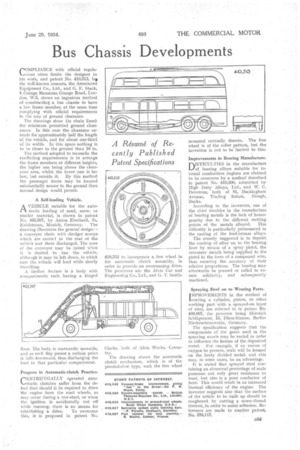Bus Chassis Developments
Page 107

If you've noticed an error in this article please click here to report it so we can fix it.
A Résumé of Recently Published Patent Specifications COMPLIANCE with official regulaLions often limits the designer in his work, and patent No. 410,513, law the well-known concern, the Associated Equipment Co., Ltd., and G. F. Stack, 4, Grange Mansions, Grange Road, London, W.5, shows an ingenious method of constructing a bus chassis to have a low frame member, at the same time complying with official requirements in the way of ground clearance.
The drawings show (in chain lines) the minimum permitted ground clearances. In this case the clearance extends for approximately half the length of the vehicle, and for about one-third of its width. In this space nothing is to be closer to the ground than 10 in.
The method adopted to reconcile the conflicting requirements is to arrange the frame members at different heights, the higher one being above the clearance area, whilst the lower one is below, but outside it. By this method the passenger doors may be located substantially nearer to the ground than normal design would permit.
A Self-loading Vehicle.
A VEHICLE suitable for the automatic loading of sand, snow, or similar material, is shown in patent No. 405,567, by Anton Eberhard, 3a,
Kohlstrasse,, Munich, Germany. The drawing illustrates the general design— a conveyer chain with dredger scoops which are carriel to the rear of the vehicle and there discharged. The nose of the conveyer may be raised when it is desired to run the vehicle, although it may be left down, in which case the vehicle will load while slowly travelling.
A further feature is a body with compartments each having a hinged floor. The body is rearwardly movable, and as each flap passes a certain point it falls downward, thus discharging the load in that particular compai talent.
Progress in Automatic-clutch Practice.
CENTRIFUGALLY operated autoN.-...matic clutches suffer from the defect that should it be required to drive the engine from the road wheels, as may occur during a tow-start, or when the ignition is accidentally cut off while running, there is no means for
establishing a drive. To overcome this, it is proposed in patent No. 410,252 to incorporate a free wheel in the automatic clutch assembly, in order to provide an overrunning drive. The patentees are the Alvis Car and Engineering Co., Ltd.., and G. T. Smith Clarke, both of Alvis Works, Coventry. The drawing shows the automatic clutch mechanism, which is of the pivoted-shoe type, with the free wheel mounted centrally therein. The free wheel is of the roller pattern, but the invention is not to be limited to this.
Improvements in Bearing Manufacture.
DIFFICULTIES in the manufacture of bearing alloys suitable for internal combustion engines are claimed to be overcome by a method described in patent No. 410,300, submitted by High Duty Alloys, Ltd., and W. C. Devereux, both of 81, Buckingham Avenue, Trading Estate, Slough, Bucks.
According to the inventors, one of the chief troubles in the manufacture of bearing metals is the lack of homogeneity due to the different melting points of the metals alloyed. This difficulty is particularly pronounced in the casting of the lead-bronze alloys.
The remedy suggested is to deposit the coating of alloy on to the bearing liner by means of a spray pistol, the necessary metals being supplied to the pistol in the form of a compound wire, thus ensuring the accuracy of their relative proportions. The bearing may afterwards be pressed or rolled to ensure solidarity, and subsequently machined.
Spraying Steel on to Wearing Parts.
I'IMPROVEMENTS in the method of coating a cylinder, piston, or other working part with a sprayed-on layer of steel, are referred to in patent No. 408,067, the patentee being Heinrich Schlfipmann, 15, Fliess-Strasse, BerlinNiederschoneweide, Germany.
The specification suggests that the components of the gases used in the spraying nozzle may be varied in order to influence the hature of the deposited metal. For example, if an excess of oxygen be present, scale will be formed on the finely divided metal, and this may, in some cases, be an advantage.
It is stated that sprayed steel containing an abnormal percentage of scale possesses not only great resistance to wear, but also is a poor conductor of heat. This would result in an increased. thermal efficiency of the engine. The inventor suggests also that the surface of the article to be built up should be roughened by cutting a screw-thread thereon, in order to assist adhesion. References are made to another patent, No. 370,117.
































































































































































